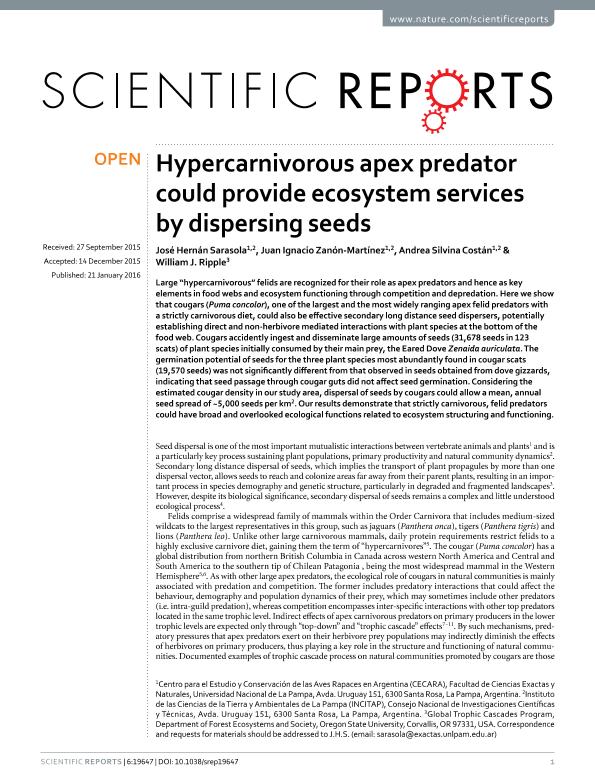Artículo
Hypercarnivorous apex predator could provide ecosystem services by dispersing seeds
Fecha de publicación:
01/2016
Editorial:
Nature Publishing Group
Revista:
Scientific reports
ISSN:
2045-2322
Idioma:
Inglés
Tipo de recurso:
Artículo publicado
Clasificación temática:
Resumen
Large ?hypercarnivorous? felids are recognized for their role as apex predators and hence as key elements in food webs and ecosystem functioning through competition and depredation. Here we show that cougars (Puma concolor), one of the largest and the most widely ranging apex felid predators with an strictly carnivorous diet, could be also effective secondary long distance seed dispersers, potentially establishing direct and non-herbivore mediated interactions with plant species at the bottom of the food web. Cougars accidently ingest and disseminate large amounts of seeds (31,678 seeds in 123 scats) of plant species initially consumed by their main prey, the Eared Dove Zenaida auriculata. The germination potential of seeds for three of the weedy/invasive plant species more abundantly found in cougar scats (19,570 seeds) was not significantly different from that observed in seeds obtained from dove gizzards, indicating that seed passage through cougar guts did not affect seed germination. Considering the estimated cougar density in our study area, dispersal of seeds by cougars could allow a mean, annual seed spread of ~5,000 seeds per km2. Our results demonstrate that strictly carnivorous, felid predators could have broad and overlooked ecological functions related to ecosystem structuring and functioning.
Palabras clave:
Secondary Seed Dispersal
,
Apex Predators
,
Large Felids
,
Cougar
Archivos asociados
Licencia
Identificadores
Colecciones
Articulos(INCITAP)
Articulos de INST.D/CS D/L/TIERRA Y AMBIENTALES D/L/PAMPA
Articulos de INST.D/CS D/L/TIERRA Y AMBIENTALES D/L/PAMPA
Citación
Sarasola, José Hernán; Zanón Martínez, Juan Ignacio; Costan, Andrea Silvina; Ripple, William; Hypercarnivorous apex predator could provide ecosystem services by dispersing seeds; Nature Publishing Group; Scientific reports; 6; 1964; 1-2016; 1-7
Compartir
Altmétricas




